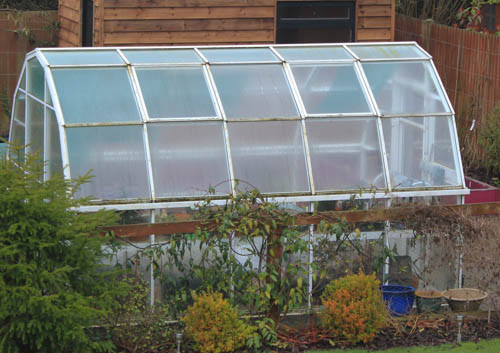
From now on my monthly tips are going to focus on what to do in the greenhouse, so let’s start with a few tips what to look for when buying a greenhouse.
Buy the largest you can afford and leave space for expansion because however large your glasshouse, it will never be large enough!
It should be orientated to receive sunshine throughout the day. In the northern hemisphere it receives more light in winter running east to west; running north to south it receives good light in summer as the sun travels from east to west.
When choosing the frame, powder coated aluminium needs little maintenance and the thin glazing bars cast little shade, naturally coloured frames blend in well with the garden; white only looks good if it is clean.
Make sure you can stand upright comfortably inside under the eaves, taking into account the space taken by shelving for seed trays in spring. Taller the glasshouses have better light transmission so a wider range of plants can be grown. The area covered by roof vents on both sides of the greenhouse should be 15-20% of the floor area in larger greenhouses and greater in small greenhouses which are prone to overheating during hot weather, though shading will help. Louvred vents in the sides are useful but draughty in winter. Ideally, vents should be opened by hand; automatic ventilation is a bit slow to take effect but useful when you are on holiday or at work. A combination of manual and automatic works well, if it is going to hot, open the door and a couple of windows in the morning before going to work and let the automatic ventilation respond to weather changes during the day. Temperatures over 27C damage many plants. Glazing should be of toughened glass; keep it clean and 90% of available light is transmitted.
Let me give you a rough idea of what happens in my Hartley greenhouse throughout the year. It is orientated north to south, with two borders either side of a short central path. Tomatoes are planted on the right-hand border in summer, they provide shade plants growing underneath the bench on the left-hand side, with aubergines, sweet peppers, chillies and ornamentals like pelargoniums on top. Aubergines and tomatoes are near the door with cucumbers in the far corners away from the door, where temperatures and humidity are higher.
My greenhouse is used to germinate seeds and ‘grow on’ plug plants in spring, for salads in autumn and storage of tender plants from the tropical borders in winter with a few tweaks and twists. Insulating the whole greenhouse in winter is quite a task, and the cost of keeping it just above freezing quite expensive so the root balls are dried and the plants draped in two layers of horticultural fleece as a winter blanket. The most tender plants are put by a propagator, with its cover removed, set at around 10C, to keep them warm and the heat spreads down the blanket of fleece like a duvet.
Happy gardening! Matt


